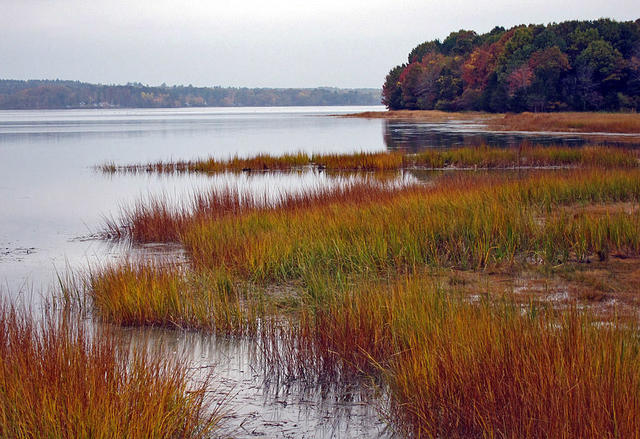Home » Regions » North America » Eastern Temperate Forests » Mixed Wood Plains » Northeastern Coastal Zone » Gulf of Maine Coastal Lowland
Gulf of Maine Coastal Lowland
Last updated: July 24th, 2020
Page contents
↑About the Gulf of Maine Coastal Lowland
The Gulf of Maine Coastal Lowland is a region extending along the Atlantic coast, from Massachusetts just south of Boston, northeast through New Hampshire's coast and into the southwesternmost portions of Maine. It consists of two separate pieces, a small piece south of Boston and a larger one to the northeast.This region is covered by glacial sand, silt, and clay, overtop bedrock of mostly metasedimentary rocks. The topography consists of flat to irregular plains inland, with coastal areas featuring beaches, bays, and tidal flats. There are extensive salt marshes in much of this region, contrasting with the rockier coastline farther north. The climate is humid and continental, but with moderating effect of the ocean. Precipitation is high and roughly equally distributed year-round, with only slightly drier summer than spring and fall. The shape of the coastline and the presence of Cape Cod separates this area from more southerly regions, leading it to be significantly colder, and mostly protected from hurricanes, but more often affected by nor'easters in winter. The growing season here averages only 135-165 days.
Forest cover varies a lot by site. Uplands, more common inland, support Appalachian oak-pine forests with northern red oak (Quercus rubra), white oak (Quercus alba), and black oak (Quercus velutina), together with eastern white pine (Pinus strobus), sugar maple (Acer saccharum), red maple (Acer rubrum), various hickories, and some other hardwoods. The southern portion of this region also has occasional scarlet oak (Quercus coccinea) and chestnut oak (Quercus montana). Swamps are dominated by red maple or Atlantic white cedar (Chamaecyparis thyoides). Bogs support pitch pine (Pinus rigida), highbush blueberry, maleberry (Lyonia ligustrina), and catberry (Ilex mucronata). Sand dunes are covered by a grassland community of beach grass, beach pea, red raspberry, seaside goldenrod (Solidago sempervirens), and beach heather. On sheltered sites behind the dunes, woodlands consist of pitch pine, beach plum, and bayberry. Saltmarshes feature saltmeadow cordgrass, smooth cordgrass, spike-grass, and saltmarsh rush.
Like much of New England, this area was historically farmed, but most of the agriculture has been abandoned in recent years. There is some remaining pasture and cropland. Currently, this area is being increasingly utilized for urban and suburban development. This region contains Portland, the largest city in Maine, but most of the development in this region has been decentralized, a lot of it driven by commuting to Boston and other cities.
This region is bordered to the southwest by the milder Narragansett/Bristol Lowland. It does not directly border the region including Cape Cod. The southern portion of this region is bordered to the west by the Southern New England Coastal Plains and Hills. The two portions of this region are separated by the Boston Basin, which includes most of Boston. The northern part of this region is bordered inland by the Gulf of Maine Coastal Plain, and at the far north, it shares a small border directly with the Sebago-Ossipee Hills and Plains. Moving northeast along the coast, it is bordered by the rockier Midcoast.
 This photo shows a salt marsh in Great Bay National Wildlife Refuge, New Hampshire. The coastline in this region is mostly on flat terrain, which leads there to be more coastal wetlands, and also leads deciduous forests, which prefer richer soils, to be found closer to the coast. Photo by Matt Poole, U.S. Fish and Wildlife Service, Public Domain, Source.
This photo shows a salt marsh in Great Bay National Wildlife Refuge, New Hampshire. The coastline in this region is mostly on flat terrain, which leads there to be more coastal wetlands, and also leads deciduous forests, which prefer richer soils, to be found closer to the coast. Photo by Matt Poole, U.S. Fish and Wildlife Service, Public Domain, Source.Plant Lists & In-Region Search
We do not yet have data to generate plant lists for a region as fine-tuned as this one. However you can move up to the broader Northeastern Coastal Zone and generate lists for that region: native plants or all plants. Or search that region's plants here:
↑References
1. Griffith, G.E., Omernik, J.M., Bryce, S.A., Royte, J., Hoar, W.D., Homer, J.W., Keirstead, D., Metzler, K.J., and Hellyer, G. "Ecoregions of New England (Poster)", U.S. Geological Survey (2009) Web.


